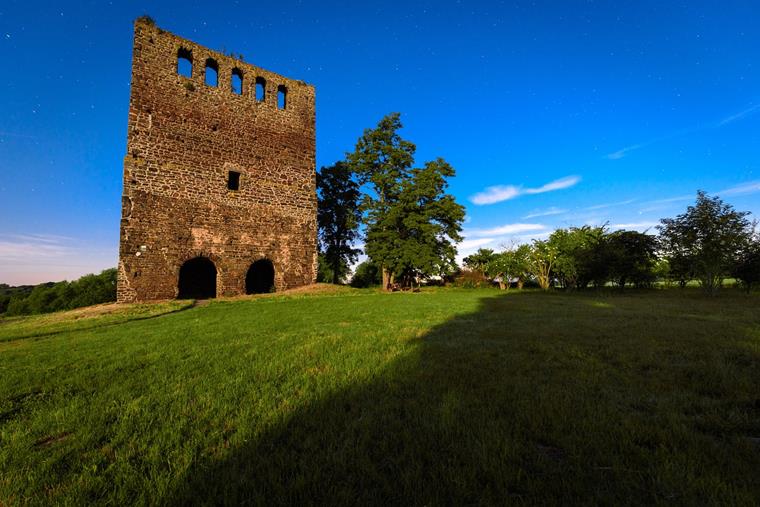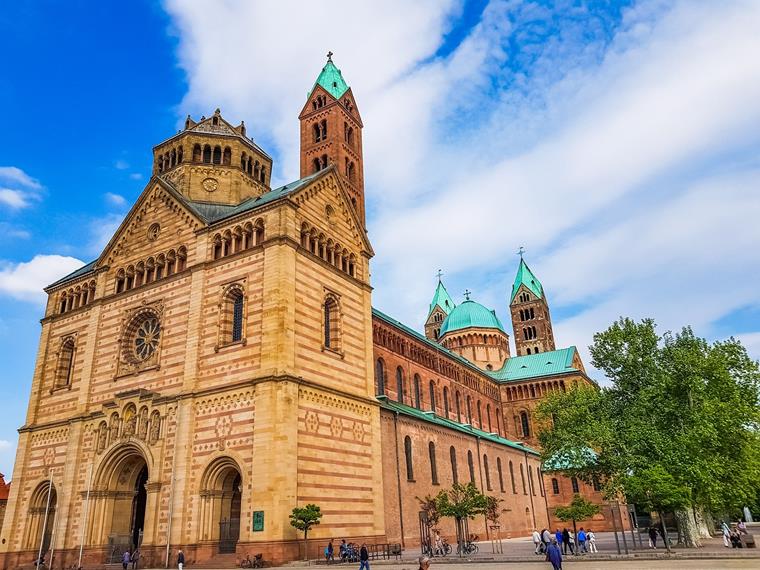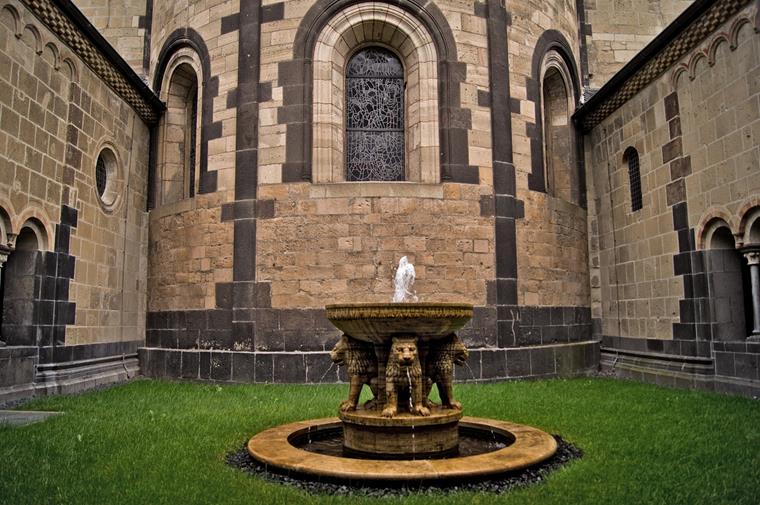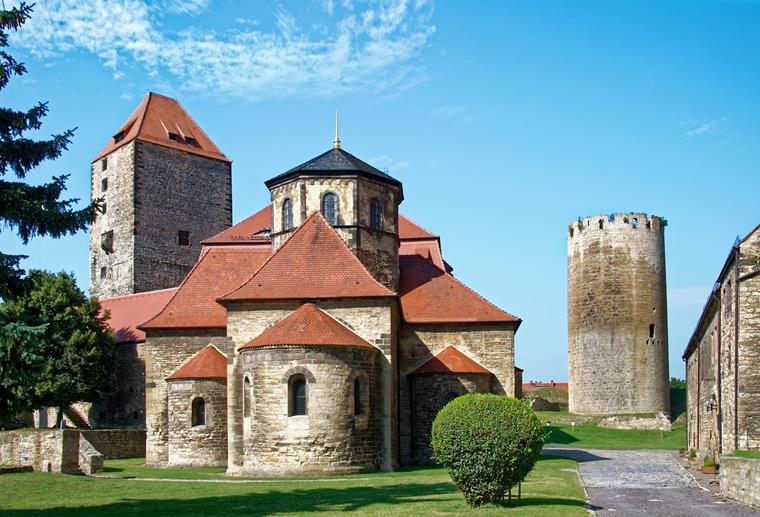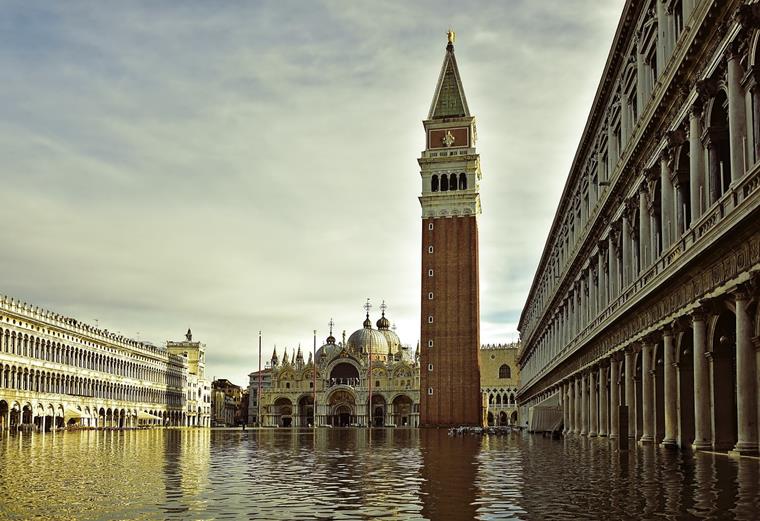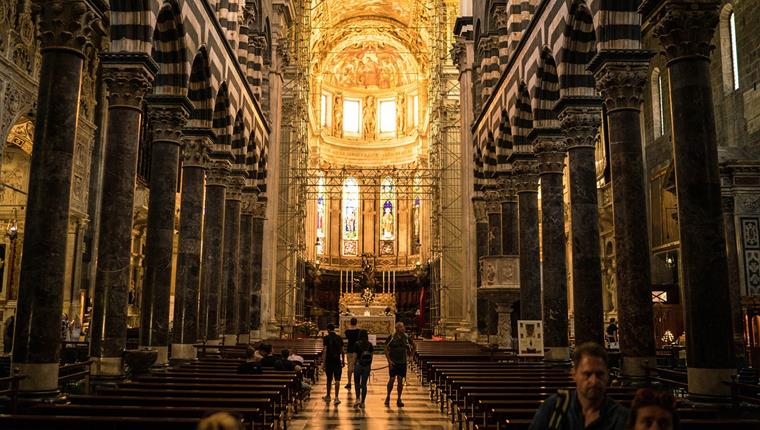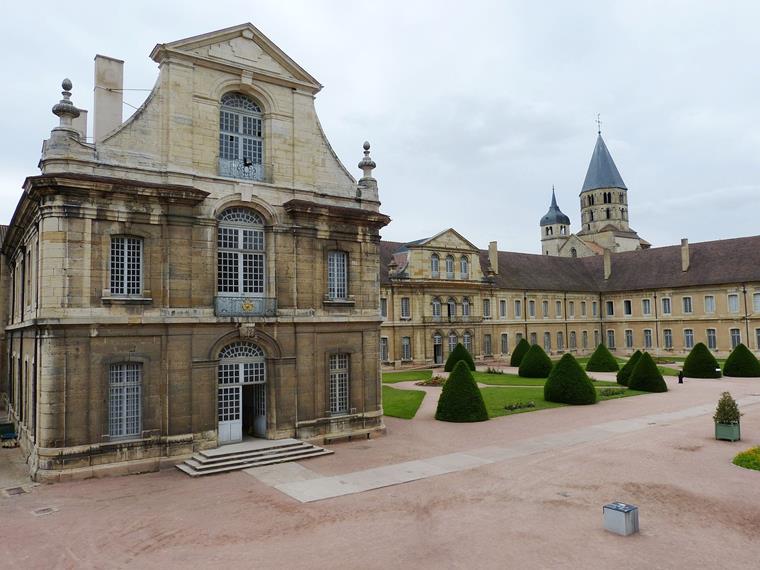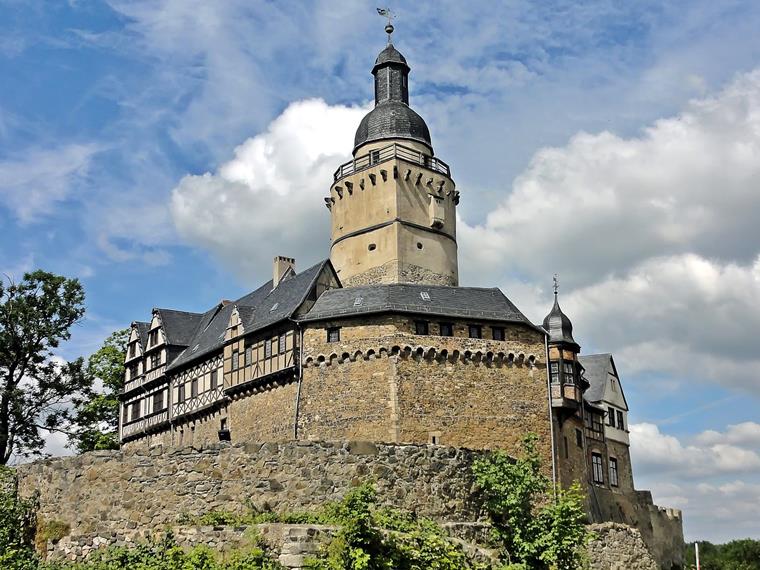In ancient times, many magnificent buildings were created that are still a source of inspiration for many people today: whether in architecture, engineering, or interior design of buildings. Structural masterpieces often saw the light of day after decades of construction, and some have survived to this day. If you are interested in ancient architecture, read on here:
Ancient Architecture: Architectural Wonders of AntiquityWith the beginning of the Middle Ages, a new era also dawned in architecture. We know them: the magnificently solid buildings, such as churches, castles, and monasteries, with their small windows and large, welcoming, round arches. In this blog post, we take a closer look at the most interesting of them and what we can still learn from the builders and architects of that time. We take you on a journey to Europe in the Middle Ages!
The Romanesque period influenced the buildings of the Middle Ages from around 900 to 1240. In France and Italy, these numbers differ only slightly. Many well-known landmarks of European cities date from this time. The architectural style itself, with its round arches, pillars, and columns, is somewhat reminiscent of ancient Roman architecture. So, let us take a closer look at a selection of impressive Romanesque buildings and their history.
Romanesque in Germany
Many Romanesque buildings that are still intact today are located in Germany. Central Germany, in particular, has a large number of Romanesque castles, palaces, monasteries, and churches. Those interested in the Romanesque Road can gaze at most of them. This route runs over 1,000 km through Saxony-Anhalt and connects 88 selected structures from the Romanesque era in 73 locations. Since 2007, it has also been networked throughout Europe.
Imperial Cathedral Basilica of the Assumption and St. Stephen in Speyer
Rhineland-Palatinate
Around 1030, the Salian ruler Conrad II commissioned the construction of a Romanesque cathedral. His goal was clear: He wanted to build one of the largest churches of its time, if not the largest. In the Middle Ages, it was common practice for the construction of the largest possible cathedral to underpin the claim to rulership.
Whoever was able to have the largest possible cathedral built was particularly godly and more than qualified for the position of Holy Roman emperor. In 1039, however, Conrad was buried on the construction site of the cathedral, and his son, Emperor Henry III, continued the work on the building. We know this from the Crusades and the sale of indulgences: What rulers did in the Middle Ages did not always make sense. And excuses were your best friend.
The cathedral was only consecrated in 1061 under Emperor Henry IV, his grandson. However, the huge building was barely completed when Henry began extensive renovation. Why? Again, it was about power: He probably wanted to demonstrate his claim to power, especially to the Pope.
In the course of this renovation, the nave received a vault, among other things. It is the largest vault known since ancient times. In 1106, the construction work was completed, as was the life of the imperial ruler, and it was the longest church in the world at the time. Today, Speyer Cathedral is also the largest intact Romanesque church in Germany.
Like most great buildings from the Middle Ages, Speyer Cathedral was not saved from severe damage. When the War of the Palatinate Succession escalated in 1689, graves were broken into and plundered. Parts of the nave were destroyed in a fire and only the high Romanesque east part remained intact. In the mid-18th century, the French Revolution broke out immediately after the reconstruction. Again, a large part was destroyed, and the dome barely escaped complete demolition in 1806.
In the 19th century, the building was redesigned and its Romanesque appearance was restored during the major renovations of the 1950s. Additionally, the pillars were strengthened with cement injections to increase their stability. Speyer Cathedral was included in the list of UNESCO World Heritage Sites in 1981.
Benedictine Abbey Church of Maria Laach, Glees
Rhineland-Palatinate
The monastery of Maria Laach was founded in 1093. As of that time, it was used as a Prussian manor, among other things, and was partially destroyed in 1855. In 1892, the monastery was resettled by Benedictine monks from the Archabbey of Beuron, becoming the center of the German liturgical movement as well as a center for intellectual, artistic, and technical activities.
The heart of the historic monastery complex of Maria Laach is the abbey church. The construction began in 1093 and it is still considered one of the most beautiful and best-preserved Romanesque monuments today.
The three-aisle, double-quired pillared church with its two transepts and six towers was built of brown-yellow Laacher tuff, white limestone from Lorraine, and red Kylls sandstone, and has retained its charm to this day. What is particularly interesting about this monument is the underground crypt.
From the Chapel of the Holy Cross, you can enter the oldest part of the Basilica. The construction began under the reign of Count Palatinate Henry II, the founder of the monastery, and the high bases on the limestone columns as well as the clear cube capitals are very similar to the style of the Speyer Cathedral Crypt. While the original is located in the Landesmusem Bonn, the first abbot of the monastery, Gilbert, who died in 1152, rests here under a simple marble slab.
The porch of the church, the so-called "Paradise", is an almost square atrium, dated to the 13th century. On the three wings with open arcades, numerous capital sculptures show sins and contentious issues of the world of that time. Visitors to the church should be aware of their mistakes and sins and ready to renounce them before entering the heart of the complex. A speciality is that It is the only preserved atrium haven north of the Alps.
Querfurt Castle
Impregnable Castle
For over 1,000 years, Querfurt Castle has risen above the roofs of the city of the same name in the south of Saxony-Anhalt, Germany. The three imposing towers quickly catch the eye: the Torture Tower, the Fat Henry, and the Paris Tower. Two ring walls and the strong fastenings underline the massive construction of the Romanesque period. As a castle from the Middle Ages, it is still a cultural center and popular destination for visitors. Querfurt Castle is the largest and the oldest castle on the Romanesque Road in Germany.
The castle was first mentioned in the Hersfeld Tithe Directory, which covered the years 866-899. However, their origin is assumed to be an earlier period. It was used as the ancestral seat of the Noble House of Querfurt until the main line died out in 1496. The Archbishopric of Magdeburg obtained title to the castle, and the counts changed frequently.
As one of the oldest and largest castles in Central Germany, it was also the scene of escalating sieges during the Thirty Years' War. Until that time, it was considered impregnable. After it changed to Prussian property in 1815 and was later used as an administrative center and residential building, scientific investigations and excavations began in the 1930s and 1980s.
From sumptuous vaults to secret subway passages: The castle has a lot to offer from an architectural historical point of view that is still very well preserved today. No wonder, then, that it has been used as a film set for national and international productions. Among others, “The Medicus” and “Popestin” were filmed here as well as numerous other fairy-tale movies.
Romanesque Buildings in Europe
In Germany, we have already visited three interesting buildings in the Romanesque style. Now, our digital journey continues through Early Middle Ages Europe. The typical Romanesque style continues here and other impressive buildings await us. Particularly interesting are the regional features, showing a wide variation of the Romanesque architectural style.
St Mark's Campanile
Venice
The construction of the original tower goes back to the Doge Pietro Tripuno and was ill-fated. The construction work was interrupted several times and was only finished under Tributo Memmo, who ruled from 979 to 991. In 1152, a spire made of fired clay was added to the tower.
The characteristic sound arcades in the style of the original from 1178 can still be seen today. Further renovations followed, such as the placing of the sculpture of Archangel Gabriel in 1517, which shapes the image of the tower to this day. This wooden sculpture was probably also the namesake of the so-called flight of angels, which has been documented as a custom on Carneval Tuesday since 1548. This is about acrobatics on a rope that is tensioned coming down from a tower.
It is currently the tallest building in Venice, and sustained extensive damage due to earthquakes and lighting strikes, so it was necessary to restore it. Unfortunately, structural errors were made here. The metal anchors inside the tower were removed in order to install an elevator. This devastating decision took its revenge a bit later. Large cracks formed in the masonry, and on the 14th of July, 1902, the tower collapsed.
Then, it was decided to rebuild the tower in the same way and place it had been.
The architectural history was not considered, because in addition to the traditional masonry, the new building consists partly of reinforced concrete. The pile foundations remain from the original, which were only reinforced. Today, visitors can use an elevator to reach the bell story.
San Lorenzo Cathedral
Genoa
The Cathedral of San Lorenzo is considered to be a building spanning different eras. You can find features of both the Romanesque and the Gothic architectural style here. This is mainly due to the long construction time of about 400 years for the Italian church.
In fact, the history of this place goes back even further. It is assumed that the first cathedral at this location was built in the 5th or 6th century, but not only that. Excavations have uncovered remains of Roman walls, street monuments, and even an ancient churchyard. The construction of the Romanesque church building was only started around 1100, funded by Genoa's successes in the crusades.
Like most important buildings of the Romanesque period, this Cathedral sustained serious damage over time. This time, it was not a natural disaster, but people who set the building on fire in the course of militant conflicts in 1296. Between 1307 and 1312 the facade and the arcades, including the mezzanines, were restored; the Romanesque structure was largely preserved.
In the following centuries, additions were made repeatedly, until Galezio Alessi was commissioned to reconstruct the cathedral in 1550. However, only the dome and apse were built, as well as the roofing of the nave and aisle. The construction of the cathedral was not actually completed until the 17th century.
Today, the Cathedral of San Lorenzo is part of the historic city and is located in the immediate vicinity of the popular Porto Antico, which is a tourist port of Genoa that attracts numerous visitors from all over the world every year.
Cluny Abbey
France
The church of Cluny Abbey was for a time the largest church in Christendom. According to a document dated September 11, 1910, William I, the duke of Aquitaine and Count of Mâcon, founded the city as a Benedictine monastery. He only appointed the first abbot, Berno. In contrast to what was customary at the time, he allowed the congregation to freely elect abbots. Moreover, the monastery was placed under the direct protection of the Pope.
In the mid-13th century, the abbey came under the influence of the French crown. Later, as of 1515, the French monarch appointed abbots, and the abbey lost its independence.
The buildings of the Cluny monastery also found themselves in numerous situations that were not necessarily favorable to the preservation of the Romanesque structures. During the French Wars of Religion in 1562 and 1574, the monuments were completely devastated; even the valuable archives were burned.
Finally, the abbey was sold to a trader in 1798, before 1,801 parts of the buildings were demolished as a quarry, first for the construction of a road, then for houses of the city. Under Napoleon's reign in 1806, a state stud farm, the Haras National, was established on the site.
In 1862, the monastery building and the remainder of the church were listed as historical monuments. Since then, a vocational training college has been located there, which is now part of the Arts et Métiers ParisTech university.
Summary: Romanesque Architecture
The Romanesque period was marked especially by a combination of innovative architectural achievements and religious devotion as well as the demonstration of power and influence. Every ruler wanted a religious structure that would be as tall as possible, that equated to all the others and could last for eternity. For this, mainly durable materials were used. In contrast to the rest of the urban planning in the early Middle Ages, which was characterized by short-lived, inexpensive timber structures.
The strong connection to the Christian religion caused churches and monasteries in the Romanesque period to grow into much more than spirit places of devotion. The somber interiors with high, curved roofs still teach visitors to reverence for these huge, massive structures.
Technical progress allowed the use of new structural elements, such as ribbed vaults and buttresses. The goal was to facilitate the construction of larger and more complex structures without sacrificing stability or durability. Therefore, here is the foundation of the following architectural styles.
Romanesque buildings are more than architectural masterpieces of that time. They provide an insight into the deep spirit and cultural meaning of their heyday.
What can we learn from the Romanesque period?
The construction industry is constantly evolving. We as engineers, but also other participants in the construction industry, should take with us some important food for thought from the Romanesque period.
The Romanesque period did not only use the limited technical means. Also, the materials were not always available and quite expensive. Creative solutions were needed back then as they are today, so we can master the technical challenges faced by the construction industry, such as the current shortage of resources.
Another characteristic of Romanesque architecture is undoubtedly its durability, due to the construction method and the raw materials used. In today's construction projects, we should also start planning high-quality buildings in the long term. The service life of our structures could be much longer and the use of resources lower.
Adaptability is also an important lesson to learn from the Romanesque period. It is not only the case that different regions and cultures have developed their own style, which made the Romanesque period an interesting and multi-faceted epoch. Builders got involved in the local conditions and the materials available in the region; that is, they worked with what was already available, without long transport routes or excessive reconstruction measures.
At the same time, it is often very easy to convert the Romanesque buildings: from a monastery to a school, a museum, or as living space. Therefore, it is not necessary to demolish buildings if they no longer serve their original purpose. We should also adopt this in our modern construction industry.
We can learn many things from the Romanesque period that help us, especially with regard to the sustainability and adaptability of our buildings. In this way, it is possible for us to learn from the past in order to further develop the interesting Romanesque approaches. Thus, we achieve more fascinating structures that fascinate other people long after us.
If you'd like to listen to this blog post, you can find the episode in German on our podcast:
More About Our Podcast